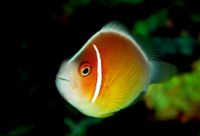Pink Anemonefish (Amphiprion perideraion)
From The Aquarium Wiki
Pink Anemonefish
Amphiprion perideraion
114 Litres (30 US G.)
7.6-10.2cm (3-4 ")
8.0 - 8.5
22.2-23.9°C (72 -75 °F)
8-12 °d
1:1 M:F
3-5 years
Family
Pomacentridae
This animal is available captive bred
Contents
Additional names
- Pink Anemonefish, Pink Skunk Clownfish, Salmon Clownfish, White-Maned Anemonefish, Whitebanded Anemonefish, False Skunk Striped Clownfish
Additional scientific names
- Amphiprion perideraeus, Amphiprion peridaeraion, Amphiprion rosenbergi, Amphiprion rosenbergii, Amphiprion amamiensis
Origin
- Western Pacific: Gulf of Thailand and Cocos-Keeling in the eastern Indian Ocean to Samoa and Tonga, north to the Ryukyu Islands, south to the Great Barrier Reef, and New Caledonia.
Sexing
- These are hermaphroditic Clownfish. They are monogamous, and host an anemone with one large female, a smaller male and several juveniles. If the female is removed, the male will change sex and one of the juveniles will become the new functioning male.
- The males tend to have pink or orange on both tail and dorsal fin and females show up with more white fins.
- These Clowns have been successfully bred in aquariums, so if you're looking to buy, we recommend seeking out captive bred specimens.
Tank compatibility
- Primarily hosts the Heteractis magnifica anemone. It is sometimes seen associated with three other anemones: Heteractis crispa, Mactodactyls doreenis and Stichodactyla gigantea.
- Can be territorial towards other Clownfish, so should be the only Clownfish species in the tank. A pair or group should be fine but watch for behaviour clashes. Do not keep with overly boisterous tank mates.
Diet
- Not a particularly fussy eater and should be fed a varied diet. Offer food such as chopped shrimp and frozen herbivore preparations. If kept with smaller or juvenile shrimp species, they may be eaten!
Feeding regime
- Feed once a day.
Environment specifics
- Best kept in a reef tank with lots of rocky caves and rubble to hide in. Will primarily hang out with their anemone and not want to venture far from it.
Behaviour
- A generally peaceful little Clown but can be territorial towards other Clown species.
- The Pink Skunk Clownfish can “sing” using their teeth and jaw pops to amplify sound for attack and defence.
Identification
- Similar to the Skunk Clownfish, but the body has more of a pinkish tinge, and there is a slender vertical white bar just behind the eye.
Pictures
External links
- Fishbase (Mirrors:
 )
)



